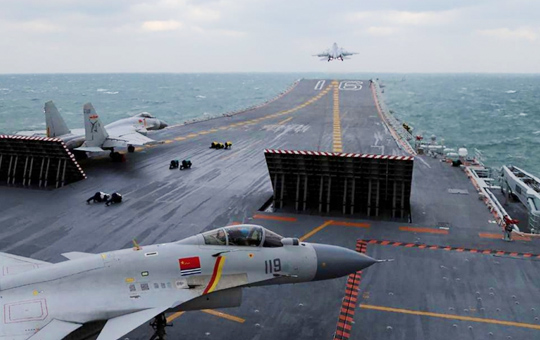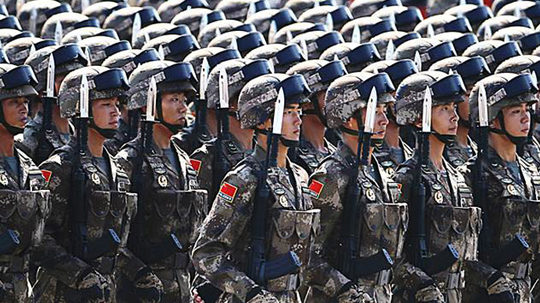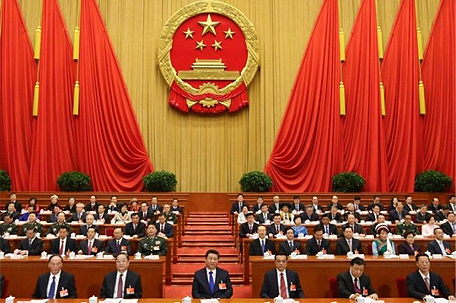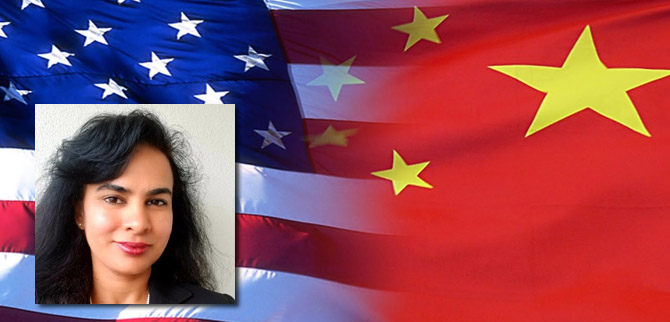China’s Strategy in the Asia-Pacific: Establish Presence and Influence by Dr Namrata Goswami
Dr. Namrata Goswami is an author, strategic analyst and consultant on counter-insurgency, counter-terrorism, alternate futures, and great power politics. After earning her Ph.D. in international relations, she served for nearly a decade at India’s Ministry of Defense (MOD) sponsored think tank, the Institute for Defence Studies and Analyses (IDSA), New Delhi, working on ethnic conflicts in India’s Northeast and China-India border conflict. She is the author of three books, “India’s National Security and Counter-Insurgency”, “Asia 2030” and “Asia 2030 The Unfolding Future.” Her research and expertise generated opportunities for collaborations abroad, and she accepted visiting fellowships at the Peace Research Institute, Oslo, Norway; the La Trobe University, Melbourne, Australia; and the University of Heidelberg, Germany. In 2012, she was selected to serve as a Jennings-Randolph Senior Fellow at the United States Institute of Peace (USIP), Washington D.C. where she studied India-China border issues, and was awarded a Fulbright-Nehru Senior Fellowship that same year. Shortly after establishing her own strategy and policy consultancy, she won the prestigious MINERVA grant awarded by the Office of the U.S. Secretary of Defense (OSD) to study great power competition in the grey zone of outer space. She was also awarded a contract with Joint Special Operations University (JSOU), to work on a project on “ISIS in South and Southeast Asia”. With expertise in international relations, ethnic conflicts, counter insurgency, wargaming, scenario building, and conflict resolution, she has been asked to consult for audiences as diverse as Wikistrat, USPACOM, USSOCOM, the Indian Military and the Indian Government, academia and policy think tanks. She was the first representative from South Asia chosen to participate in the George C. Marshall European Center for Security Studies NATO Partnership for Peace Consortium (PfPC) ‘Emerging Security Challenges Working Group.’ She also received the Executive Leadership Certificate sponsored by the Harvard Kennedy School of Government, National Defense University (NDU), and the Asia Pacific Center for Security Studies (APCSS). Currently, she is working on two book projects, one on the topic of ‘Ethnic Narratives’, to be published by Oxford University Press, and the other on the topic of ‘Great Power Ambitions” to be published by Lexington Press, an imprint of Rowman and Littlefield.
 For China, the Asia-Pacific (in their terminology), Indo-Pacific for the U.S. [a term first coined in 2007 by Japanese Prime Minister, Shinzo Abe],[1] is located within their vision of the China dream. This concept of a dream that is packaged as attractive for countries along the Asia-Pacific is that of a China that is willing to invest its resources to share a co-prosperity sphere with countries along this critical strategic sphere. The Chinese dream was boldly articulated by President Xi Jinping in his address to the National Museum of China on November 29, 2012.[2] For Xi, the ‘China dream’ is his signature concept, similar to Mao Tse Tung’s ‘Class Struggle’, Deng Xiaoping’s ‘Four Modernizations’, Jiang Zemin’s ‘The Three Represents’, and Hu Jintao’s ‘Harmonious Society’.[3] Significantly, Xi articulated the concept after touring an exhibition titled ‘The Road to Revival’, in the National Museum. Xi restated his ‘China dream’ in his inaugural address to the 19th Communist Party of China (CPC) National Congress in 2017.[4] In his address, Xi specified why China was an attractive option. For one, while the U.S. inflicted the 2008 financial crisis on the world, and created regional instabilities, China stood firm on its own economic prosperity and entered a ‘new normal’ where the Chinese economic development model was only growing stronger. China enjoyed a Gross Domestic Product (GDP) of 82.7 trillion yuan (US$12.86 trillion) in 2017,[5] maintained its position as the second largest economy in the world, and contributed 30 per cent to global economic growth, an achievement the CPC was proud of. For another, as part of that China dream, Xi encouraged projects that improved standards of living, strengthened Chinese democracy based on socialistic characteristics, and built an ecologically conscious civilization.[6] Towards establishing that highly developed Chinese state, the focus was on strengthening its military, to include war preparedness across multi-domains (land, air, sea, space and cyber), especially towards meeting the goal of the CPC: national rejuvenation of the Chinese nation and people. This goal is spearheaded by the CPC in all fields, by maintaining its ability to chart the course of institutions within China by presence, ideological guidance and indoctrination.[7]
For China, the Asia-Pacific (in their terminology), Indo-Pacific for the U.S. [a term first coined in 2007 by Japanese Prime Minister, Shinzo Abe],[1] is located within their vision of the China dream. This concept of a dream that is packaged as attractive for countries along the Asia-Pacific is that of a China that is willing to invest its resources to share a co-prosperity sphere with countries along this critical strategic sphere. The Chinese dream was boldly articulated by President Xi Jinping in his address to the National Museum of China on November 29, 2012.[2] For Xi, the ‘China dream’ is his signature concept, similar to Mao Tse Tung’s ‘Class Struggle’, Deng Xiaoping’s ‘Four Modernizations’, Jiang Zemin’s ‘The Three Represents’, and Hu Jintao’s ‘Harmonious Society’.[3] Significantly, Xi articulated the concept after touring an exhibition titled ‘The Road to Revival’, in the National Museum. Xi restated his ‘China dream’ in his inaugural address to the 19th Communist Party of China (CPC) National Congress in 2017.[4] In his address, Xi specified why China was an attractive option. For one, while the U.S. inflicted the 2008 financial crisis on the world, and created regional instabilities, China stood firm on its own economic prosperity and entered a ‘new normal’ where the Chinese economic development model was only growing stronger. China enjoyed a Gross Domestic Product (GDP) of 82.7 trillion yuan (US$12.86 trillion) in 2017,[5] maintained its position as the second largest economy in the world, and contributed 30 per cent to global economic growth, an achievement the CPC was proud of. For another, as part of that China dream, Xi encouraged projects that improved standards of living, strengthened Chinese democracy based on socialistic characteristics, and built an ecologically conscious civilization.[6] Towards establishing that highly developed Chinese state, the focus was on strengthening its military, to include war preparedness across multi-domains (land, air, sea, space and cyber), especially towards meeting the goal of the CPC: national rejuvenation of the Chinese nation and people. This goal is spearheaded by the CPC in all fields, by maintaining its ability to chart the course of institutions within China by presence, ideological guidance and indoctrination.[7]
The present crop of Chinese leaders (the fifth generation) are not shy about hiding China’s ambitions and capabilities. While the Chinese dream emphasizes ‘harmony, peace, stability and wealth creation’, the CPC is willing and has demonstrated tremendous capacity to shape and influence the regional and international environments to serve the Chinese dream. Interconnected therefore to the China dream is the Asia-Pacific dream where countries can fulfil their goals of prosperity and development for their own people by connecting themselves and investing in a China led international order that promises such peace and stability.
In this endeavor, the fifth generation of leadership led by President Xi has activated the following strategic means to achieve optimal ends for their preferred world order where Western led international institutions are one of the players in the game of international relations, and not the sole dominant players.

Strategic Means
The strategic means that China has adopted for its Asia-Pacific dominance goal are the following.
First, create initiatives aimed at Asia-Pacific countries. Second, build institutions and norms that support those initiatives. Third, build a military capable of implementing a China preferred international order. Fourth, demonstrate that the U.S. is no longer an attraction option, both societally and internationally to its allies.
Initiatives Aimed at the Asia-Pacific
China’s Belt and Road Initiative (BRI) or more commonly known as the One Belt, One Road (OBOR) translated from “yi dai yi lu”, is an initiative that aims to develop economic connections between Asia, Africa and Europe. The initiative targets nearly 71 countries with prospects of enjoying China’s co-prosperity sphere. China has already expended $210 billion on this initiative. Most of the construction work is given to China’s booming construction industry which is a ‘line of credit’ offered by China to partner countries. That itself creates a strategic debt and entanglement, for those countries who cannot afford that kind of massive infrastructure. The significance of the OBOR is gauged from the fact that it is now part of the CPC constitution.[8] The OBOR includes a 21st century maritime Silk Road as well as an OBOR space corridor. The grandiose nature and scale of the initiative, and the fact that it is President Xi’s pet project, with no Presidential term limits, is that China will gradually create enough incentives for countries along the OBOR to buy into its projects, more so, because it targets countries where infrastructure development is sorely required. And not every country views China from the framework of an adversary as is the case with the U.S. or India, both of whom have thrown their weight behind renaming the ‘Asia-Pacific’ as the ‘Indo-Pacific’. Neither China, nor countries within its sphere of influence have adopted the renaming of the region.[9] China will not accept that reframing of the ‘Asia-Pacific’ as the ‘Indo-Pacific’ in the future either given the originator of the idea is Japan, a regional rival. The exact opposite is true with China renaming areas with Chinese names, for instance in the Antarctic[10] to include asserting Chinese names on disputed territory as well as marked projects.[11] To build up legitimacy, support and analysis on the OBOR, China has a dedicated government website on the OBOR initiative that includes information on policy, projects, reach, perspectives from other countries, tax incentives for growth, tourism and international cooperation.[12] Interestingly, certain Western analysis on OBOR attempts to dismiss its impact as they suspect the real motivation behind the initiative is to profitably engage the excessive Chinese industrial capacity it built and ensure energy supply lines.[13] However, that attempt to negate the strategic impact of the initiative as a purely self-interested enterprise strikes me as odd because with growing economic engagements and entanglements comes the added incentives of accruing power and influence. It also matters how it has been framed. For instance, President Xi announced the BRI initiative in a 2014 Conference on Interaction and Confidence-building Measure in Asia, a clever strategic move.
Building Institutions and Norms
To forward the China dream, President Xi and Premier Li Keqiang has established institutions like the Asian Infrastructure Investment Bank (AIIB), lent their support to the Asia-Pacific Economic Cooperation (APEC), and has offered economic alternatives to the Trans Pacific Partnership (TPP), from which the U.S. exited, like the Regional Comprehensive Economic Partnership (RCEP). More importantly, on June 29, 2018, China established the first and second international commercial courts in Xi’an and Shenzhen to deal with disputes arising out of its OBOR initiatives under the guidance and regulations of its Supreme People’s Court (SPC). As per the stipulations offered by the SPC, the judges of these courts must be Chinese nationals. There will be an International Commercial Expert Committee which will consist of Chinese and international experts from the OBOR countries, who can offer legal advice.[14] The aim of these courts is to be a ‘One Stop’ dispute resolution mechanism along China’s Maritime Silk Road as well as the land-based Silk Road Economic Belt. Interestingly, an official from China’s Council for the Promotion of International Trade (CCPIT), specified that the spirit behind China based courts was the fact that Chinese companies involved in Belt and Road initiatives are not comfortable with international courts that are dominated by American and European common law legal terminologies. Consequently, it is time for China to lead in establishing alternative dispute resolution mechanisms that are based on its own indigenous legal concepts and ideas.[15] Similarly, China is creating an OBOR Space Investment and Information Corridor,[16] where outer-space is part of the OBOR projects, offered to countries in that sphere. China is thereby taking lead in offering its upcoming permanent space station for science projects and international collaborations in partnership with the United Nations Office for Outer Space Affairs (UNOOSA), as part of a joint effort announced last year.[17] In May 2017, China hosted the Belt and Road Forum attended by 29 heads of states and delegations from 130 countries.[18] This effort at institution building, and its related norms and standard operating procedures is a successful effort at showcasing Chinese leadership, not only in terms of committing resources to a project, but towards establishing long term institutions that ensures its continuance because it builds stakes not only by China but also partner countries towards ensuring its success.

China’s Military under Xi
Towards ensuring that a preferred international order is established and maintained, the role of the Chinese military must be optimal. The American led international order aimed at free trade is mostly ensured by the presence of the U.S. Navy in the oceans, as well as its ability to dominate the air and space. This is in addition to the West led international institutions that sets norms globally headquartered in Western cities like New York and Geneva. Recently, however, the credibility of that dominance has been questioned by China, especially after it established artificial islands in the South China Sea (SCS), and subsequently turned it into a military base by installing radars, by developing missile shelters for long range surface to air missiles.[19] In response, nothing much could be done then to sail a few U.S. naval warships close to the islands. The PLA’s capability to project power and establish presence has increased in the last few years due to focused reorganization and operational training, coupled with its increasing presence in OBOR countries with the legitimate aim to secure Chinese companies conducting projects there. For instance, the presence of PLA personnel along the Chinese funded $62 billion China-Pakistan Economic Corridor (CPEC) has been reported, primarily to offer security for Chinese projects but could be utilized for the dual purpose of conflict.[20] Similarly, China has established its first out of area military base in Djibouti, Africa.[21] Under President Xi, the focus is clear: build a military that is capable of winning wars. The PLA must secure the leadership of the CPC, first and foremost, and the socialist system that China champions. The series of reforms constituted since 2012 under the 18th Party Congress is aimed at shaping the PLA into the best ‘informationized’ armed forces. Significantly, military institutional reform has been undertaken, to include the establishment of the PLA Rocket Force, the PLA Strategic Support Force, and the PLA Army General Command. The idea, behind these changes, is to ensure domination and maintain access, across the spectrum of conflicts, to include land, air, sea and space. For Xi, China will emerge as the strongest country in the world by 2050, a path that he is destined to shape and lead, given he has appointed himself President for life.[22]
China is the Attractive Option
China thrust behind its Asia-Pacific strategy is to showcase its initiatives as well as its diplomacy as one of harmony and stability. This directly challenges the Western discourse that China is a threat to the liberal American led international order. While those of us who question China’s increasingly assertive behavior about disputed territories with countries like Vietnam, Philippines, India, Bhutan, Chinese policy makers and academics forward the argument that these areas are Chinese territory historically. Consequently, China is simply reclaiming its own ‘lost territories’. Consequently, China’s behavior cannot be viewed from the prism of revisionism that the West is prone to frame it as. For Chinese scholars, the West’s narrative of creating a ‘threat scenario’ regarding China’s rise as a major power is because their overarching aim is to ensure their own dominance in the West led economic order, from which their citizens benefit disproportionally given their head start with colonialism and its consequent exploitation of other societies’ resources.[23] This lead is maintained by Western powers, the Chinese narrative goes, by creating global institutions in which they occupy dominant decision making powers, with headquarters of such institutions mostly located in the U.S. or other European countries. Such behavior can be gauged from the fact that the U.S. Congress blocked reform to the International Monetary Fund (IMF) in 2014 to a package that would have handed over more voting powers to countries like China, Brazil, India, Russia and South Africa.[24] This move would have reduced the dominance of Western Europe as well in these international monetary institutions. China argues that these organizations, designed to ensure that the West continues to benefit from its colonial past, as well as from its dominance, is now directly challenged by the alternate institutions China has established based on inclusion, and aimed at social stability and peace. Interwoven into all this is the idea of the ‘China dream’ that promises wealth and prosperity for those who partake in it. In this, China has taken over leadership by establishing its own rules and norms of investments, instead of waiting for the present international institutions to initiate a new set of rules. The idea is to demonstrate that China has its own agency in not only being a ‘norm follower’ but also in constituting its own norms. Its has gone about establishing Free Trade Areas (FTA), build institutions, establish military presence and reach, as well as conduct global summits in its territory. Consequently, in the present context, with U.S. President Donald Trump creating tariff barriers, declaring himself a nationalist, with an ‘America First’ policy, China has quietly stepped in, and offered itself as a viable and responsible alternative.

The concern is, what is that alternate we have. China as a state embodies a totalitarian socialist system led by the CPC, with ever increasing technical mechanisms of controlling dissent and targeting opponents. China’s social credit system,[25] its emphasis on ensuring that all the institutions of the state exist to ensure the dominance of the CPC, its emphasis on one party loyalty, and its curtailment of free speech means that a China led order would have little patience for democratic haggling and legitimate dissent, instead constructing legitimacy structure for a unitary perspective as we have encountered in their claims over territory. However, we need to realize that the China option is aimed at making it attractive and successful to the rest of the world. Given its deft diplomacy and long-term commitment capabilities with little change in internal political regime, China has the advantage of offering a long-term vision of stability and economic prosperity to the world. After all, we have the example of the successful story of Lee Kuan Yew’s Singapore, a tightly controlled one party, the People’s Action Party (PAP) led political entity, and on whose example, Deng Xiaoping built the edifices of his modern China.[26] To China, Singapore’s legitimacy based dictatorship is a model worth emulating given the city state’s reputation, to include excellent living standards, boosting the world’s second most powerful passport with visa-free entry to 189 countries, just behind Japan’s with free access to 190 countries.[27] CPC fifth generation leaders view the Asia-Pacific in their terminology as a zone of proximate influence. Consequently, China will continue to invest in building legitimacy and commit resources to ensure that in the long run, it is China, not the U.S. who emerges as the leader. That’s the Chinese strategic end goal towards which we will see little or no compromise.
[1] “What’s in a Name? Understanding the ‘Indo-Pacific”, The Japan Times, June 3, 2018 at https://www.japantimes.co.jp/opinion/2018/06/03/editorials/whats-name-understanding-indo-pacific/#.XA_nZ3RKiUk (Accessed on December 11, 2018).
[2] “Xi Pledges “Great Renewal of Chinese Nation”, National Museum of China, November 29, 2012 at http://en.chnmuseum.cn/Default.aspx?TabId=521&InfoID=86595&frtid=500&AspxAutoDetectCookieSupport=1 (Accessed on December 12, 2018).
[3] William A. Callahan, “History, Tradition and the China Dream: Socialist Modernization in the World of Great Harmony”, Journal of Contemporary China, 24/96, 2015, pp. 983-1001 at https://www.tandfonline.com/action/showCitFormats?doi=10.1080%2F10670564.2015.1030915 (Accessed on December 12, 2018).
[4] Xi Jinping, “Secure a Decisive Victory in Building a Moderately Prosperous Society in All Respects and Strive for the Great Success of Socialism with Chinese Characteristics for a New Era”, Delivered at the 19th National Congress of the Communist Party of China, October 18, 2017 at http://www.xinhuanet.com/english/download/Xi_Jinping’s_report_at_19th_CPC_National_Congress.pdf (Accessed on December 5, 2018).
[5] Frank Tang, “China’s Economy Expands by 6.9 p.c. in 2017, ending Six Years of Slowing Growth”, South China Morning Post, January 19, 2018 at https://www.scmp.com/news/china/economy/article/2129508/chinas-economy-expands-69pc-2017-ending-six-years-slowing-growth (Accessed on December 13, 2018).
[6] Xi Jinping, “Secure a Decisive Victory in Building a Moderately Prosperous Society in All Respects and Strive for the Great Success of Socialism with Chinese Characteristics for a New Era”, n.4.
[7] Zha Daojiong, “China’s Economic Diplomacy Focusing on the Asia-Pacific Region”, China Quarterly of International Strategic Studies, 1/1, 2015, pp. 85-104.
[8] Lily Kuo and Niko Kommendo, “What is China’s Belt and Road Initiative?”, The Guardian, July 30, 2018 at https://www.theguardian.com/cities/ng-interactive/2018/jul/30/what-china-belt-road-initiative-silk-road-explainer (Accessed on December 5, 2018).
[9] Rory Metcalf, “Why China Doesn’t Like the Indo-Pacific and Why it Matters”, Australian National University, National Security College, June 21, 2017 at https://nsc.crawford.anu.edu.au/department-news/12613/why-china-doesnt-indo-pacific-and-why-it-matters (Accessed on December 12, 2018).
[10] Anne-Mary Brady, “China’s Rise in Antarctica?”, Asian Survey, 50/4 (July/August
[11] “Arunachal Pradesh: China Renames Districts in Disputed Indian State”, BBC, April 19, 2017 at https://www.bbc.com/news/world-asia-india-39638543 (Accessed on December 13, 2018).
[12] “The Belt and Road Initiative”, The State Council, The People’s Republic of China, December 5, 2018 at http://english.gov.cn/beltAndRoad/ (Accessed on December 5, 2018).
[13] Anna Bruce-Lockhart, “China’s $900 Billion New Silk Road. What You Need to Know”, World Economic Forum, June 26, 2007 at https://www.weforum.org/agenda/2017/06/china-new-silk-road-explainer/ (Accessed on December 12, 2018).
[14] For more, please see Clyde & Co LLP, “China Establishes International Commercial Courts to Resolve International Commercial Disputes”, Lexology, August 24, 2018 at https://www.lexology.com/library/detail.aspx?g=cb279b59-f4d3-44f5-bde5-7f0ac5710dff (Accessed on December 6, 2018).
[15] “China to Establish Court for OBOR Disputes”, Asia Times, January 25, 2018 at http://www.atimes.com/article/china-establish-court-obor-disputes/ (Accessed on December 6, 2018). Also see
[16] Echo Chang, “China is Building its New Silk Road in Space, Too”, Quartz, June 18, 2018 at https://qz.com/1276934/chinas-belt-and-road-initiative-bri-extends-to-space-too/ (Accessed on December 6, 2018).
[17] “United Nations and China Invite Applications to Conduct Experiments on-Board China’s Space Station”, United Nations Office for Outer Space Affairs, May 28, 2018 at http://www.unoosa.org/oosa/en/informationfor/media/2018-unis-os-496.html (Accessed on December 13, 2018).
[18] “Belt and Road: 2017 Summit”, South China Morning Post, at https://www.scmp.com/topics/belt-and-road-2017-summit (Accessed on December 13, 2018).
[19] “China Builds New Military Facilities on South China Sea Islands: Think Tank”, Reuters, June 29, 2017 at https://www.reuters.com/article/us-southchinasea-china-islands/china-builds-new-military-facilities-on-south-china-sea-islands-think-tank-idUSKBN19L02J (Accessed on December 6, 2018).
[20] Ayaz Gul, “China Welcomes Saudi Plans to Invest in CPEC Project with Pakistan”, VoA, October 08, 2018 at https://www.voanews.com/a/china-welcomes-saudi-plans-invest-cpec-project-with-pakistan/4604946.html (Accessed on December 6, 2018).
[21] Tyler Headley, “China’s Djibouti Base: One Year Update”, The Diplomat, December 04, 2018 at https://thediplomat.com/tag/china-djibouti-base/ (Accessed on December 6, 2018).
[22] “President Xi Allowed to Remain ‘President for Life’ as Term Limits Removed”, BBC, March 11, 2018 at https://www.bbc.com/news/world-asia-china-43361276 (Accessed on December 6, 2018).
[23] Jiang Ye, “Will China be a “Threat” to its Neighbors and the World in the Twenty First Century?”, Ritsumeikan Annual Review of International Studies,1, 2002, pp. 55-68 at http://www.ritsumei.ac.jp/acd/cg/ir/college/bulletin/e-vol1/1-4jiang.pdf (Accessed on December 13, 2018).
[24] Anna Yukhananov, “U.S. Congress Closes Out Year Without Passing IMF Reform”, Reuters, December 10, 2014 at https://www.reuters.com/article/us-usa-congress-imf/u-s-congress-closes-out-year-without-passing-imf-reforms-idUSKBN0JO1UC20141211 (Accessed on December 13, 2018).
[25] “China’s Social Credit System”, NPR, October 9, 2018 at https://www.npr.org/sections/money/2018/10/09/655921710/chinas-social-credit-system (Accessed on December 6, 2018).
[26] Carry Huan, “How Lee Kuan Yew Crafted Singapore into a Role Model for China”, South China Morning Post, March 24, 2015 at https://www.scmp.com/news/china/article/1746072/how-lee-kwan-yew-crafted-singapore-role-model-china (Accessed on December 6, 2018).
[27] Henley & Partners Passport Index, “Global Ranking 2018” at https://www.henleypassportindex.com/passport-index (Accessed on December 6, 2018).


